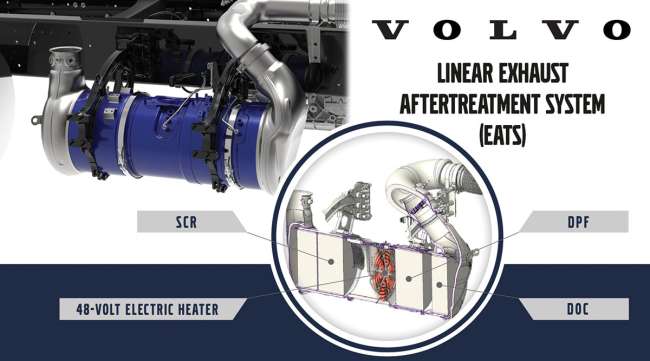Diesel OEMs Working to Meet 2027 EPA Standards

[Stay on top of transportation news: Get TTNews in your inbox.]
The Environmental Protection Agency and California Air Resources Board have established that NOx and particulate emissions from diesel trucks have an adverse effect on respiratory and cardiac health.
Since 2010, truck diesels have used exhaust gas recirculation together with selective catalytic reduction requiring the use of diesel exhaust fluid to get rid of most of the NOx in diesel exhaust. At the same time, the diesel particulate filter introduced in 2007, along with improved combustion systems, controlled particulate matter.
The two systems appeared to be extremely effective, but as time went by, regulators discovered deterioration in the performance of both forms of aftertreatment, especially the SCR system, when trucks were crawling along the highway, as happens in heavy traffic. An EPA press release on the 2027 Clean Trucks Plan final rulemaking states, “The final rule ... establishes not only new, much more stringent NOx standards compared to today’s standards, but also requires lower NOx emissions over a much wider range of testing conditions.”
RELATED: EPA Sets Strict Emissions Standards for Heavy Trucks
The systems thus far have depended on hot exhaust to work. This means the basic SCR system works well when the engine is under load at highway cruising speeds, but, because diesels have no throttle, it cools down and becomes much less effective when crawling in traffic, running bobtail or idling. At low loads, the injection system cuts fuel to a tiny fraction of what’s needed at highway speeds while airflow drops only marginally (because of reduced turbo boost pressure), creating much cooler exhaust.

Baxter
The 2027 NOx standard drops from 200 milligrams per horsepower-hour at present down to just 35 mg/horsepower-hour, and 10 mg/horsepower-hour at idle. But the current basic technology is so effective when hot enough for the catalytic action to work at its best that we don’t need a new system. All that is necessary is to keep the system hot. The idle limit is so low because the extremely high ratio between air and fuel under that condition means low combustion temperatures, reducing engine-out NOx.
While not all the engine makers are revealing details, it’s becoming clear that the industry has largely settled on a simple solution for 2027, and that is electric heating of one or both aftertreatment systems powered by a separate high-voltage alternator. Such a system will add little weight and complexity, and by multiplying the 12 volts currently used by a factor of three to 48 volts, the gauge of the wiring will be minimized and the efficiency of the alternator will be maximized because of much lower amperage. Lower amps minimize the power needed to provide the heating.
Particulate matter, too, was seen as an issue, and the 2027 standard will drop from the present 100 mg/horsepower-hour to just 5. However, research shows that the present DPF is such a fine filter that under ideal operating conditions and together with the continued improvements in injection and combustion systems since 2010, it can meet the standard. Keeping it at peak efficiency, in part via temperature maintenance, will largely meet the standard. Interestingly, the more effective NOx control for 2027 provided by an improved SCR system will allow engine efficiency to rise via different tuning, in part to meet GHG requirements.
Unburned hydrocarbons and carbon monoxide will also need to be reduced, but these are dealt with in the diesel oxidation catalyst that directly precedes the DPF.
OEM Action
Cummins’ solution to 2027, according to Mark Ulrich, director of customer support, will involve no extensive architectural changes. The aftertreatment system will be slightly larger and it will incorporate two electric heaters supplied by a belt-driven, 48-volt alternator that powers only the emission system heaters. One heater will precede the diesel oxidation catalyst that sits at the front of the DPF, and the second will sit at the intake of the SCR catalyst. The two heaters will ensure continual, peak NOx reduction no matter how low engine loads may go. Because of the way temperature is maintained in the SCR catalyst, only a single doser located at that component is required and there will be only a small increase in DEF usage.
Host Seth Clevenger and TT's Connor Wolf discuss CES 2025 and the emerging technologies that could push the trucking industry forward.. Tune in above or by going to RoadSigns.ttnews.com.
“The catalysts in an aftertreatment system work together as a system. In addition to removing particulates, the chemical reactions in the diesel oxidation catalyst and DPF filter are also critical for generating heat that enables the SCR catalyst to convert NOx. These heat-generating reactions require a minimum operating temperature,” said Andy Smith, Cummins Emission Solutions product management leader, adding that the inlet heater on the DPF assembly ensures that these catalysts come up to temperature quickly and remain there during low load conditions, such as extended idling.
Cummins will have a new version of the X15 known as the HELM (“higher efficiency, lower emissions, multiple fuels”) series that will help meet the reduced greenhouse gas standard for 2027. The new platform will feature such fuel-saving technology as newly designed coolant passages that have much lower resistance to flow, reducing water pump parasitics, a dual overhead camshaft layout that improves breathing, a shorter piston with a longer connecting rod that lowers internal friction, and a new combustion system. The latter system allows the Efficiency Series engines to run a higher compression ratio of 22.8:1 and a higher expansion ratio (Atkinson Cycle with expansion greater than compression) than before. This alteration improves efficiency.
Want more news? Listen to today's daily briefing above or go here for more info
“The piston plays a critical role in emissions, performance and efficiency of the engine. Emissions can be influenced by the shape of the piston bowl, which is designed in concert with injector characteristics, such as spray angle,” said Jared Holcomb, Cummins’ on-highway product manager. By optimizing the piston bowl, injector, injection strategy and airflow through the cylinder, Cummins was able to improve emissions while balancing overall efficiency and performance. “Through sizing of the piston bowl, we are able to vary the compression ratio,” he added.
Volvo already has a leg up on the 2027 GHG standards via the new VNL, including its improved aerodynamic design and engine improvements like the shorter piston and longer connecting rod for reduced friction. Continued development of drivetrain systems, including I-torque with its 2.15:1 axle ratio and its ability to run at cruise speed in any of three gears to retain performance, will complete the picture along with continued development in areas like aerodynamics.
Daimler Truck North America’s Whitney Anderson, corporate communications spokesperson, told Calibrate the new Detroit Diesel engines will feature updates that will deliver better fuel economy and will feature a new aftertreatment system. Full technical details will be shared at a later date.





